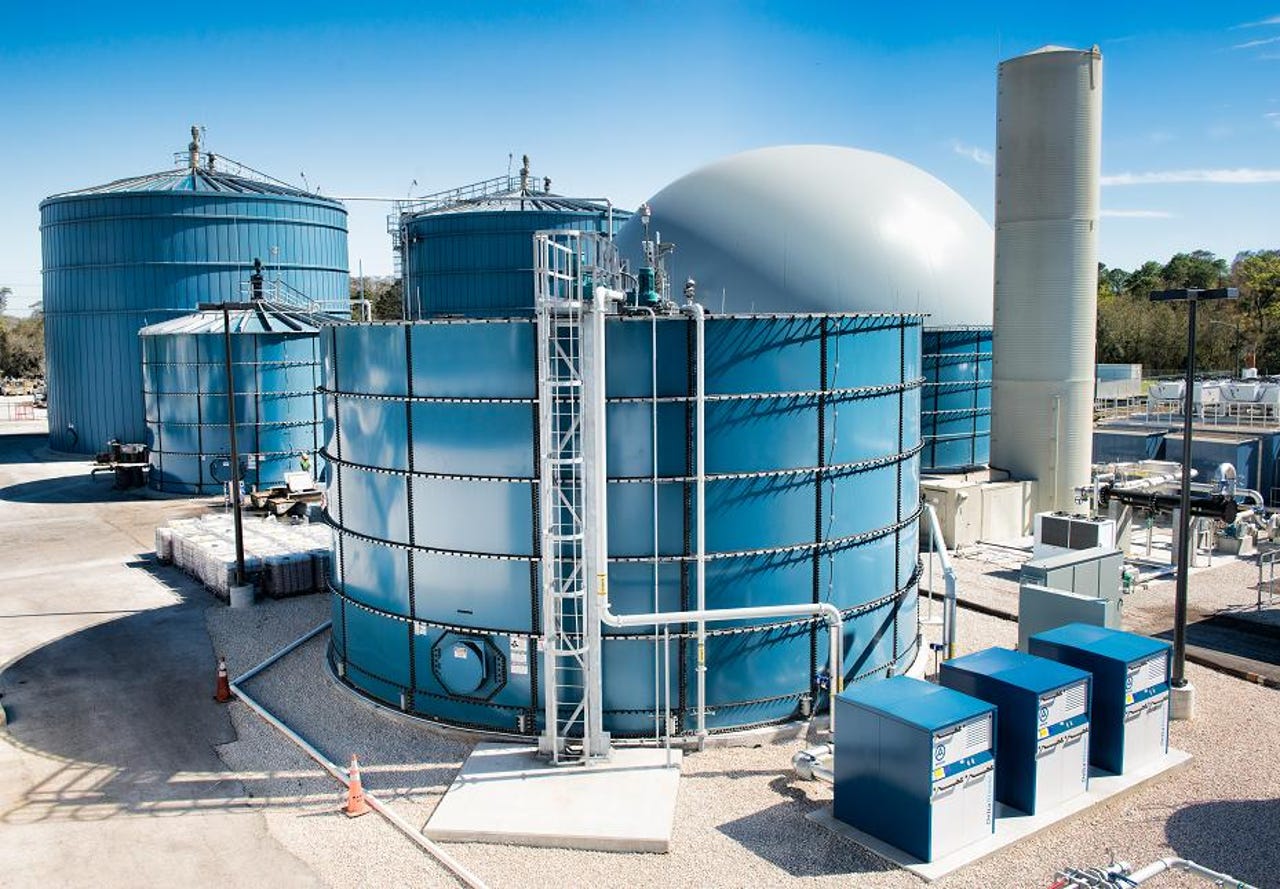Could food waste power our cities?


In two giant airtight vats at Harvest Power’s Energy Garden in central Florida, quadrillions of microorganisms are feasting on orange peels, wilted lettuce, burnt bread crusts, and other food discarded by humans. In less than a month, these ravenous creatures consume waste that would have taken years to decompose in a landfill.
Better yet, they release immense amounts of gas — biogas, to be exact. This heady mix of roughly 60 pecent methane and 40 percent carbon dioxide is fed into generators to produce electricity to help power area businesses.
“A biogas system is a great way to solve a lot of problems,” says Chris Peters, the Harvest Power Regional Vice President overseeing the Florida Energy Garden. “It diverts material from landfills, creates sustainable electricity, and produces useful byproducts in the form of fertilizer and treated wastewater. It’s a win-win.”
Hosted by Reedy Creek Improvement District (RCID), which was created in the 1960s to provide infrastructure services for Walt Disney World and now also serves other businesses in Lake Buena Vista and Bay Lake, Florida, Harvest Power’s Energy Garden was unveiled in February 2014. The facility began by collecting food waste from Walt Disney World’s table-service restaurants and has quickly drawn additional customers in central Florida, where Peters says an average of 24 pounds of food waste is sent to landfills every second.
Harvest is currently processing food waste at a rate of 45,000 tons per year, including 15,000 tons from RCID and 30,000 tons from other sources. This food waste is combined with fats, oils and grease (FOG) and biosolids (treated sewage) for a total of 120,000 tons of organic waste being handled by the plant per year.
Once prepared, the waste is fed into 1.2 million-gallon tanks where anaerobic (meaning without oxygen) digestion takes place. The carefully balanced blend of waste and warm temperatures optimize conditions for the microorganisms to thrive, feed and produce the all-important biogas.
Biogas is released by food waste in landfills too, albeit much more slowly, and most of the methane escapes into the atmosphere instead of being contained. Methane is a harmful greenhouse gas so containing it in a biogas plant has an immediate environmental benefit.
The biogas at Harvest’s Florida Energy Garden creates 27 million kilowatt hours of electricity per year, enough to power 2,300 homes, and is sold to RCID to help keep the lights on at Walt Disney World, among other places. In addition, Harvest sells fertilizer and irrigation water gleaned from the anaerobic digestion process.
Anaerobic digestion is not a new technology. “It’s a microbial process that’s been around since the beginning of time — the same thing happens in a cow’s stomach,” points out Patrick Serfass, Executive Director of the American Biogas Council, founded in 2010 and based in Washington, DC. But biogas facilities are more common in Europe, especially in Germany, because of a shortage of landfill space, high energy costs, and a more favorable political climate for renewable energy alternatives, according to Serfass.
Still, Serfass says there have been biogas plants in the US for many decades, mostly at wastewater treatment facilities. What’s new is a focus on using these systems to process some of the 133 billion pounds of food wasted in America each year. Cleanworld in Sacramento recently started a biogas plant that converts community food waste into power for the University of California at Davis. Kroger, the largest grocery store chain in America, processes spoiled food from Ralphs and Food 4 Less stores at a biogas facility to power its distribution center in Compton, California.
Several high-profile businesses near Harvest Power’s Florida Energy Garden have already climbed aboard the biogas bandwagon. Organic produce company FreshPoint Central Florida, produce distributor Taylor Farms, and hotels including the Waldorf Astoria Orlando and Grande Lakes Orlando have all struck deals to send food waste to Harvest Power.
At the Hilton Orlando Bonnet Creek & Waldorf Astoria Orlando, Managing Director Peter Kacheris says that food waste from all 13 of the complex’s restaurants will eventually be directed to Harvest instead of landfills — plus the complex plans to buy fertilizer byproducts from Harvest for its 18-hole golf course. “It’s cost-effective and also allows us to make a difference through sustainable actions,” says Kacheris, who projects that making the change will reduce the hotels’ garbage bill by about ten percent.
Large-scale diversion of food waste from landfills to biogas plants will require a shift in attitude and behavior on the part of both businesses and consumers, but Serfass says there will come a time when recycling food waste will seem as commonplace as recycling a glass bottle.
“It’s a crime that we have organic waste not being recycled and not being turned into renewable energy,” says Serfass. “We have the technology — we just have to get restaurants and grocery stores and communities to think of this waste as a resource.”